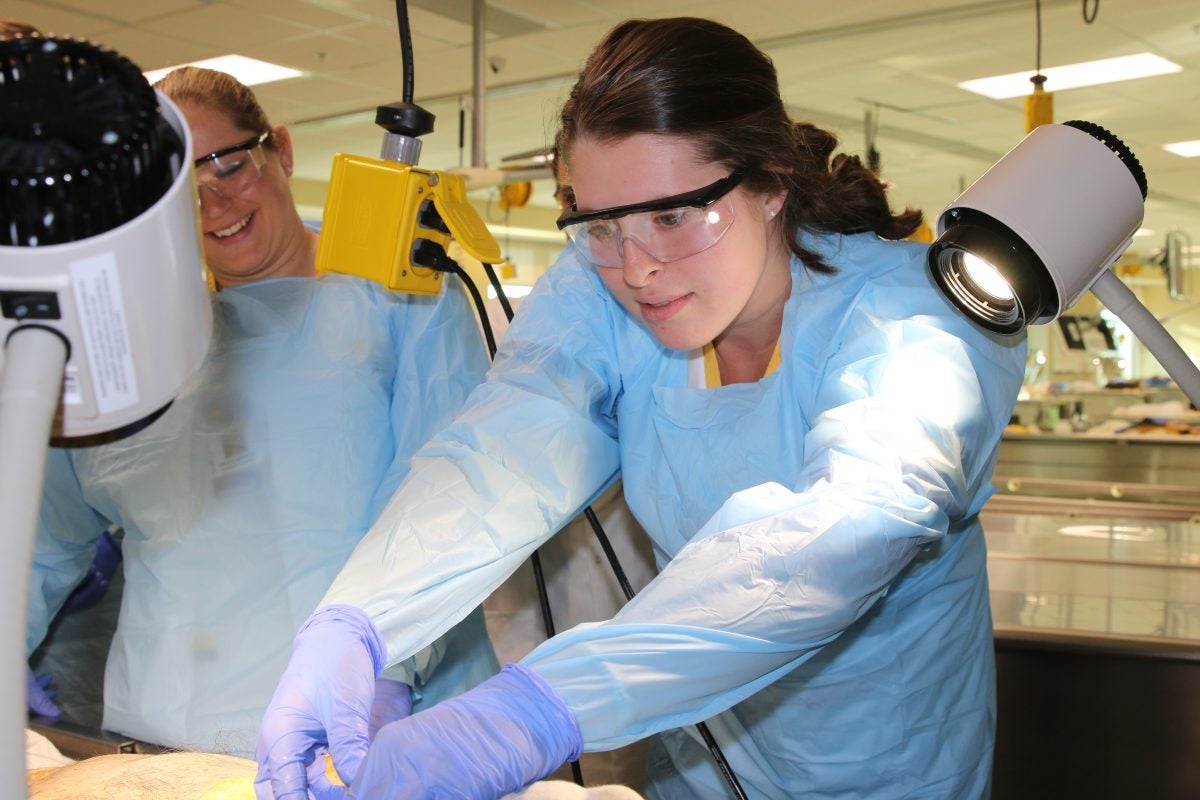Sophomore nursing student Desiree dos Anjos, was cautious but sure-handed as she inserted a tracheal tube into her patient’s throat. She had read about the procedure in textbooks and watched it done numerous times on video, but this was her first hands-on experience.
“Look how small the esophagus is,” she says, examining her patient’s neck. “Now I’m definitely going to chew my food a bit more knowing that it’s going down this small pipe into your stomach.”
“It’s definitely going to do wonders for me in helping me be a better nurse.” – Desiree dos Anjos, UCF nursing student
Her “patient” was a cadaver, a person who had donated their body to help train medical students, and her “clinic” was the UCF College of Medicine’s Anatomy Lab. Dos Anjos was one of 10 UCF College of Nursing students who trained in the lab with thanks to medical students who organized a one-day workshop Nov. 28.
“It’s been absolutely phenomenal,” dos Anjos says of her first experience learning from real humans. “I’ve learned so much, knowing how the different organs look and how they work inside the body instead of just looking at pictures in a textbook. It’s definitely going to do wonders for me in helping me be a better nurse, because I’ll have a fuller understanding of how everything actually works when I’m explaining procedures to my patients.”
The workshop was the brainchild of former critical-care-nurse-turned-UCF-medical student Will Pruitt. After getting trained in the Anatomy Lab during his first year of medical school, Pruitt realized how valuable such a learning experience would have been during his nursing education.
“So much of what I learned during the gross anatomy module would have been tremendously helpful in multiple facets of my nursing practice,” says Pruitt, who is now in his second year of medical school. “So, I wanted to give UCF nursing students, starting with this small group, a unique learning experience that gives them an opportunity to bridge the gap between what they have learned in nursing textbooks and the actual human body.”
Only a handful of nursing schools utilize cadavers for their students’ learning. While the College of Nursing employs advanced simulation technologies, such as high-fidelity mannequins, virtual or screen-based patients, as well as clinical experience with real patients, cadaver-based learning experiences are not yet part of the curriculum.
“It’s clear from listening to the student interactions that there is much to learn and share between disciplines.” – Joyce Burr, UCF College of Nursing lecturer
“The most exciting thing for me as an educator was the absolute total engagement and enthusiasm of both the nursing and medical students during this teaching and learning experience,” says Joyce Burr, associate lecturer at the College of Nursing who helped coordinate the event. “It’s clear from listening to the student interactions that there is much to learn and share between disciplines. The medical students are teaching but they are also learning from the nursing students, and it shows that each partner on the team has something valuable to contribute, and the end product is a healthy patient.”
Pruitt worked with three other medical students and Daniel Topping, the Anatomy Lab’s director, to design a workshop curriculum that allowed nurses to see and touch core parts of the anatomy and common pathologies and review common clinical scenarios like hernias and lung damage while peering into the human body. The nurses also flushed central lines, inserted tracheal tubes and used manual resuscitators to inflate balloons as simulated lungs with medical devices donated by the Osceola Regional Medical Center.
“Nurses are at the bedside helping to place and monitor these devices, but they never really get to see what lies beneath the skin,” Pruitt says. “So we want them to get a better understanding of where these devices are traveling and how they work once they are in the body, so it will assist them when putting these devices in, and also be able to picture exactly what happens when a device fails or migrates out of place.”
“Anatomy is fundamental to any discipline involved in direct care of patients, whether nursing, speech therapy, or pharmacology.” – Daniel Topping, UCF’s Anatomy Lab director
Before studying in the lab, nursing students watched a videotape about the experience and the impact of their patient’s gift to medical education. At UCF’s medical school, cadavers are considered the student’s first patient. Medical students talked to their nursing colleagues about honoring and respecting the person’s gift to their training. Pruitt will be analyzing the impact of the experience in a research study, and hopes his results will help make the program a staple for UCF nursing students.
With the development of UCF’s new Academic Health Science Center, which will ultimately bring many UCF health programs to Lake Nona and encourage more interprofessional education, research and patient care, Topping says the Anatomy Lab workshop can be a model for future collaborations between healthcare disciplines.
“Anatomy is fundamental to any discipline involved in direct care of patients, whether nursing, speech therapy, or pharmacology. And we have such a wonderful facility and resources here, which makes perfect sense for us to collaborate and begin partnerships,” he says.
“I also feel that our donors would want as many healthcare professionals as possible to benefit from their gift,” he added. “And what better way to do it than through these interprofessional collaborations.”
To view a video version of this story, visit https://www.youtube.com/watch?v=cN5YK6FXoOI




